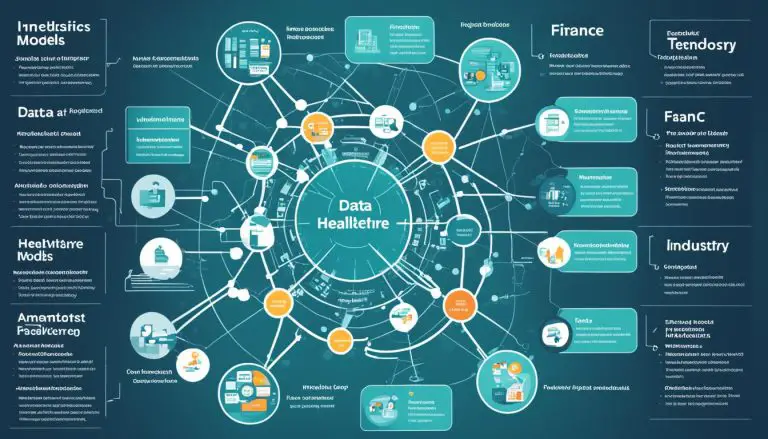Decoding Technology: What is an Algorithm?
In the world of computing, algorithms are the fundamental building blocks that power various applications and technologies. But what exactly is an algorithm? In simple terms, an algorithm is a set of instructions designed to solve specific problems or perform tasks. They are the secret sauce behind the efficient functioning of everything from search engines to social media platforms.
Algorithms can be intricate and diverse, adapting to the specific challenges they aim to address. They make sense of vast amounts of data and provide users with personalized content, making our digital experiences more streamlined and tailored to our needs.
Key Takeaways:
- Algorithms are a series of instructions that solve problems or perform tasks.
- They are the foundation of computing and essential in various applications.
- Classification, sorting, and search algorithms are among the common types.
- Algorithms play a crucial role in data analysis, image processing, and optimization.
- Understanding algorithms and optimizing content for social media algorithms can boost online presence and engagement.
Types of Algorithms
Algorithms can be classified into different types based on their purpose and functionality. Understanding these types is essential for grasping the diverse applications of algorithms in various domains. Here are some common types of algorithms:
Classification Algorithms
Classification algorithms are used to categorize data into groups or classes based on their characteristics. These algorithms analyze the input data and assign labels or categories to each data point. They are widely used in machine learning and data analysis to classify data based on patterns and attributes. Common examples include decision trees, support vector machines, and logistic regression.
Sorting Algorithms
Sorting algorithms arrange data elements in a specific order, typically in ascending or descending order. These algorithms are crucial for organizing and retrieving data efficiently. They are used in tasks such as arranging names alphabetically, sorting numbers in numerical order, or ordering items by priority. Some popular sorting algorithms include bubble sort, merge sort, and quicksort.
Search Algorithms
Search algorithms are designed to find specific elements within a dataset. They help locate a particular item or determine whether it exists in a given collection of data. Search algorithms are commonly used in applications such as finding a specific word in a document, locating a record in a database, or searching for a product on an e-commerce website. Binary search, linear search, and hash-based search algorithms are widely used in search operations.
Understanding the different types of algorithms provides a foundation for exploring their applications and potential uses in solving various problems. Whether it’s categorizing data, organizing information, or searching for specific elements, algorithms play a crucial role in modern computing.
| Algorithm Type | Functionality | Examples |
|---|---|---|
| Classification Algorithms | Categorize data into groups or classes based on characteristics | Decision trees, support vector machines, logistic regression |
| Sorting Algorithms | Arrange data elements in a specific order | Bubble sort, merge sort, quicksort |
| Search Algorithms | Find specific elements within a dataset | Binary search, linear search, hash-based search algorithms |
Importance of Algorithms
Algorithms play a crucial role in the field of computing and have immense importance in various industries and everyday life. They serve as the backbone of modern technology, enabling the efficient organization and processing of data to solve complex problems and perform tasks. Without algorithms, many of the technologies we rely on today would not be possible.
The role of algorithms goes beyond basic data processing. They contribute to the development of new technologies such as machine learning and artificial intelligence systems. These systems rely on algorithms to analyze vast amounts of data, learn patterns, and make predictions. From personalized recommendations on social media platforms to accurate search results on search engines, algorithms enable technology to understand and cater to individual user preferences.
Algorithmic efficiency is also a critical consideration. The efficiency of an algorithm determines how quickly and accurately it can solve a problem or complete a task. By optimizing algorithms, developers can improve the performance and speed of various applications, leading to better user experiences. Algorithmic efficiency is particularly important when dealing with large datasets or resource-intensive tasks, as it helps reduce processing time and resource usage.
| Role of Algorithms | Importance |
|---|---|
| Data Processing | Efficient organization and processing of data |
| Technological Advancements | Foundation for machine learning and artificial intelligence |
| User Experience | Personalized content recommendations |
| Efficiency and Scalability | Improved performance and reduced resource usage |
Algorithms are the driving force behind the technology we use every day. They enable us to process vast amounts of data, make accurate predictions, and provide personalized experiences. Without algorithms, modern technology would not be able to function efficiently or meet the demands of users. The role of algorithms is not only limited to computing but extends to various industries, making them an essential component of our everyday lives.
How do Algorithms work?
An algorithm is a step-by-step process that solves a specific problem or performs a particular task. It takes input data, applies a series of logical operations, and produces an output. The algorithmic process is a fundamental concept in computer programming and is used in various applications across different industries.
When it comes to understanding how algorithms work, it’s important to note that they can range from simple to complex, depending on the problem they are addressing. Regardless of complexity, all algorithms share a common characteristic: they follow a precise sequence of instructions. This sequence guides the algorithm through a series of operations, enabling it to solve the problem efficiently.
Step-by-step algorithms break down a problem into smaller, more manageable tasks. Each step or instruction in the algorithm is designed to perform a specific action, such as data manipulation, comparison, or conditional branching. By executing these instructions in a specific order, algorithms can process data and make decisions based on predefined rules or conditions.
| Step | Description |
|---|---|
| Step 1 | Receive input data |
| Step 2 | Perform initial data processing |
| Step 3 | Apply logical operations to the data |
| Step 4 | Make decisions based on predefined rules or conditions |
| Step 5 | Produce the desired output |
By following this step-by-step process, algorithms can efficiently solve problems and perform tasks in a wide range of fields, from data analysis to image recognition, and even complex computational problems. Understanding how algorithms work is essential for computer scientists, programmers, and anyone involved in developing or utilizing technology.
Algorithm Examples
Algorithms are widely used in various domains to solve specific problems and perform tasks. Let’s explore some examples of algorithms in different contexts:
Sorting Algorithms
Sorting algorithms are used to arrange data in a specific order. Two popular sorting algorithms are Bubble Sort and Quick Sort. Bubble Sort compares adjacent elements and swaps them if they are in the wrong order, gradually sorting the data. Quick Sort divides the data into smaller groups and sorts them recursively, ultimately achieving a sorted sequence.
Machine Learning Algorithms
Machine learning algorithms enable computers to learn and make predictions based on patterns in data. Decision Trees are a common machine learning algorithm that uses a tree-like model to make decisions based on input features. Neural Networks, inspired by the human brain, consist of interconnected nodes that can process complex patterns and make predictions.
| Algorithm | Application |
|---|---|
| Bubble Sort | Sorting arrays or lists of data |
| Quick Sort | Efficient sorting of large data sets |
| Decision Trees | Classification and prediction in machine learning |
| Neural Networks | Pattern recognition and image processing |
Algorithm Complexity Analysis
Understanding the complexity of algorithms is essential in assessing their efficiency and scalability. Algorithm complexity analysis involves evaluating two key factors: time complexity and space complexity.
Time complexity measures how the running time of an algorithm increases as the input size grows. It helps us determine how the algorithm’s performance will scale when dealing with larger datasets. Common time complexity notations include O(1), O(n), O(n^2), and so on, where “O” represents the upper bound of the complexity.
Space complexity refers to the amount of memory or storage required by an algorithm to solve a problem. It determines the algorithm’s memory usage and provides insights into the efficiency of resource utilization. Similar to time complexity, space complexity is typically denoted using the “O” notation.
“Algorithm complexity analysis is like a compass for navigating the vast landscape of computational problems. It helps us understand how algorithms perform as data scales, enabling us to choose the most efficient solutions.”
Algorithm complexity analysis allows us to make informed decisions when selecting algorithms for specific tasks. By considering both time and space complexity, we can identify algorithms that strike a balance between performance and resource usage. This analysis is crucial in designing efficient and scalable software systems, especially when dealing with large-scale data processing or real-time applications.
| Time Complexity | Space Complexity |
|---|---|
| O(1) | O(1) |
| O(n) | O(1) |
| O(log n) | O(1) |
| O(n log n) | O(1) |
| O(n^2) | O(1) |
| O(2^n) | O(n) |
Understanding Time Complexity
Time complexity measures the runtime of an algorithm as the input size increases. It helps us estimate how the algorithm’s performance will scale when dealing with larger data sets. Common time complexity notations include:
- O(1): Indicates constant time complexity. The algorithm’s runtime remains the same, regardless of the input size.
- O(n): Indicates linear time complexity. The algorithm’s runtime increases proportionally to the input size.
- O(log n): Indicates logarithmic time complexity. The algorithm’s runtime increases slowly as the input size grows.
- O(n log n): Indicates linearithmic time complexity. The algorithm’s runtime increases at a slower rate than quadratic but faster than linear.
- O(n^2): Indicates quadratic time complexity. The algorithm’s runtime increases exponentially as the input size grows.
- O(2^n): Indicates exponential time complexity. The algorithm’s runtime doubles with each additional input element.
Understanding Space Complexity
Space complexity refers to the amount of memory or storage required by an algorithm to solve a problem. It helps us understand the algorithm’s memory usage and provides insights into the efficiency of resource utilization. Common space complexity notations include:
- O(1): Indicates constant space complexity. The algorithm uses a fixed amount of memory, regardless of the input size.
- O(n): Indicates linear space complexity. The algorithm’s memory usage increases proportionally to the input size.
By analyzing both time and space complexity, we can choose algorithms that strike the right balance between performance and resource utilization. This analysis is crucial in designing efficient and scalable software systems.
Algorithm Efficiency
When it comes to algorithms, efficiency is a key factor in ensuring optimal performance and resource utilization. An efficient algorithm is one that can solve a problem or complete a task using the fewest resources possible, such as time and memory. Improving algorithm efficiency plays a crucial role in various domains, including computer science, data analysis, and artificial intelligence.
Optimal algorithms are designed to achieve the best possible efficiency in terms of time and space complexity. Time complexity refers to how the running time of an algorithm grows as the input size increases, while space complexity measures the amount of memory or storage required by an algorithm. By carefully analyzing and optimizing these factors, developers can create algorithms that can handle large datasets and complex computations effectively.
Reducing Time Complexity
In order to improve algorithm efficiency, one approach is to focus on reducing time complexity. This involves analyzing the algorithm’s steps and identifying areas where unnecessary computations or redundant operations can be eliminated. By streamlining the algorithm’s logic and optimizing its implementation, developers can significantly reduce the time required to execute the algorithm, allowing for faster and more efficient processing.
In addition, applying well-established algorithmic techniques such as memoization and dynamic programming can also help reduce time complexity. These techniques involve storing previously computed results and reusing them when needed, thereby avoiding redundant computations. By leveraging these techniques, developers can optimize the algorithm’s performance and achieve better efficiency.
| Algorithm | Time Complexity |
|---|---|
| Bubble Sort | O(n^2) |
| Quick Sort | O(n log n) |
| Insertion Sort | O(n^2) |
“Improving algorithm efficiency is crucial in achieving faster and more efficient computations. By optimizing time complexity and implementing well-established techniques, developers can reduce unnecessary computations and achieve better performance.”
Efficient algorithms are essential for solving complex problems in various domains. By focusing on improving algorithm efficiency, developers can create optimized solutions that can handle large datasets and complex computations effectively. With the continuous advancements in technology, the importance of algorithm efficiency will only continue to grow, driving innovation and enabling the development of more sophisticated applications.
Algorithm Applications
Algorithms have a wide range of applications across various industries and domains. They play a crucial role in performing data analysis and image processing tasks efficiently and accurately. Let’s explore some common applications of algorithms in these areas:
Data Analysis Algorithms
Data analysis algorithms are used to analyze large datasets and derive meaningful insights. These algorithms handle complex data structures and perform statistical calculations to uncover patterns, trends, and correlations. They are widely used in fields such as finance, marketing, healthcare, and scientific research. Data analysis algorithms enable organizations to make informed decisions, identify areas for improvement, and predict future outcomes based on historical data.
Image Processing Algorithms
Image processing algorithms are used to enhance and manipulate digital images. These algorithms handle image data at the pixel level and apply various techniques such as noise reduction, contrast adjustment, edge detection, and image segmentation. Image processing algorithms find extensive applications in areas like medical imaging, surveillance, computer vision, and photography. They enable tasks such as object recognition, face detection, character recognition, and image restoration.
| Application | Examples |
|---|---|
| Data Analysis | Customer segmentation, market basket analysis, anomaly detection |
| Image Processing | Image enhancement, object recognition, pattern detection |
“Data analysis algorithms help us make sense of mountains of data, providing valuable insights and informing decision-making processes.”
By leveraging algorithms in data analysis and image processing, businesses and researchers can gain a deeper understanding of their data and accelerate innovation in their respective fields.
AI’s Role in Social Media Algorithms
Artificial Intelligence (AI) has revolutionized the way social media platforms operate, particularly when it comes to content personalization. Machine Learning Algorithms in Social Media play a significant role in analyzing vast amounts of user data and behaviors to deliver tailored content recommendations. By leveraging AI technology, platforms can offer users personalized content that aligns with their interests, preferences, and engagement patterns.
Content personalization is a key feature of social media algorithms powered by AI. These algorithms consider various factors such as user demographics, past behaviors, interactions, and content preferences to determine the most relevant content to display. By analyzing user data, AI algorithms can predict and recommend content that is more likely to capture users’ attention and generate engagement.
Machine Learning Algorithms in Social Media have the ability to continuously learn and adapt based on user feedback. As users interact with content, AI algorithms gather data on their preferences and adjust recommendations accordingly. This iterative process ensures that content recommendations become more accurate and personalized over time, leading to increased user satisfaction and engagement.

In conclusion, AI plays a crucial role in social media algorithms by enabling content personalization. Machine learning algorithms analyze user data to deliver tailored content recommendations, enhancing the user experience. By leveraging AI technology, social media platforms can provide users with content that aligns with their interests and preferences, leading to increased engagement and platform usage.
Tips for Optimizing Content for Social Media Algorithms
To increase organic reach and boost engagement on social media, it’s important to optimize your content for algorithms. By understanding how algorithms work and adapting your strategy accordingly, you can effectively reach a wider audience and enhance your online presence. Here are some tips to optimize your content:
- Create high-quality, engaging content: Focus on creating valuable and relevant content that resonates with your target audience. This can include informative articles, entertaining videos, or visually appealing images.
- Post consistently and at optimal times: Regularly posting content can help increase visibility and keep your audience engaged. Research the best times to post on different social media platforms to maximize reach.
- Use relevant keywords and hashtags: Incorporate relevant keywords and popular hashtags in your captions and descriptions to improve discoverability. This can help your content appear in search results and reach a wider audience.
- Encourage audience engagement: Prompt your followers to engage with your content by asking questions, encouraging likes and comments, or running contests. Engaging with your audience increases visibility and helps build a loyal community.
- Analyze and monitor algorithmic trends: Stay updated on the latest algorithm changes and trends on social media platforms. Analyze the performance of your content and make adjustments to your strategy accordingly.
- Leverage multimedia content: Use a mix of images, videos, and other multimedia content to capture and maintain user attention. Visuals are more likely to be shared and can help boost engagement.
- Build a strong online presence: Engage with your audience by responding to comments, messages, and mentions. Building a rapport with your followers can increase profile authority and visibility.
- Stay relevant and up-to-date: Keep up with current trends, topics, and industry news to align your content with algorithmic interests. Creating content that is timely and relevant can increase its visibility on social media.
- Experiment with different content formats: Test different content formats and strategies to find what resonates best with your audience. This can include live videos, behind-the-scenes footage, or user-generated content.
- Analyze metrics and data: Regularly analyze the performance metrics and data of your social media content. This can help you understand the impact of algorithmic changes and make data-driven adjustments to your content strategy.
By following these tips and staying informed about algorithmic trends, you can optimize your content for social media algorithms and increase your organic reach and engagement.
Table: Best Times to Post on Social Media Platforms
| Social Media Platform | Best Times to Post |
|---|---|
| Weekdays between 9am and 2pm | |
| Weekdays between 12pm and 3pm | |
| Weekdays between 10am and 3pm | |
| Weekdays between 8am and 10am, and 12pm and 5pm | |
| Weekdays between 8pm and 11pm | |
| YouTube | Thursdays and Fridays between 12pm and 4pm |
Remember, optimizing content for social media algorithms is an ongoing process. Stay up-to-date with the latest algorithm changes and continue to experiment and refine your content strategy to achieve the best results.+
Conclusion
To conclude, algorithms are the driving force behind modern computing and have a profound impact on various industries, including social media. Understanding how algorithms work and optimizing content accordingly can greatly enhance online presence and engagement. By staying informed about algorithmic trends, adapting strategies, and creating valuable and engaging content, individuals and businesses can leverage algorithms to their advantage and reach a wider audience on social media platforms.
Key takeaways from this exploration of algorithms include the importance of algorithmic efficiency, which ensures tasks are completed in a timely manner, and the need for algorithm complexity analysis to determine scalability and performance. By understanding the types of algorithms available, such as classification, sorting, and search algorithms, one can choose the most suitable approach for specific problems.
Furthermore, algorithms find application in various domains, such as data analysis, image processing, and optimization, enabling the extraction of meaningful insights, improving image quality, and solving complex problems. The role of artificial intelligence (AI) in social media algorithms cannot be understated, as machine learning algorithms enable personalized content recommendations based on user data and behaviors.
In summary, staying informed about algorithmic trends, optimizing content, and leveraging the power of algorithms can help individuals and businesses thrive in the social media landscape. By implementing the tips for optimizing content and understanding the fundamental concepts of algorithms, one can navigate the intricate world of algorithms and harness their potential to achieve greater visibility and engagement on social media platforms.
FAQ
What is an algorithm?
An algorithm is a series of instructions designed to solve specific problems or perform tasks.
What are the types of algorithms?
There are different types of algorithms, including classification algorithms, sorting algorithms, and search algorithms.
Why are algorithms important?
Algorithms are important because they organize and process data efficiently, contribute to technological advancements, and improve computational performance.
How do algorithms work?
Algorithms work by following a step-by-step process to accomplish a specific task or solve a problem.
Can you provide examples of algorithms?
Examples of algorithms include sorting algorithms like Bubble Sort and Quick Sort, machine learning algorithms like Decision Trees and Neural Networks, and encryption algorithms like AES and RSA.
What is algorithm complexity analysis?
Algorithm complexity analysis is the study of how the performance of an algorithm changes as the input size increases.
How can algorithm efficiency be improved?
Algorithm efficiency can be improved by optimizing the algorithm’s design, using efficient data structures, and implementing algorithmic techniques such as memoization and dynamic programming.
What are the applications of algorithms?
Algorithms have various applications in data analysis, image processing, optimization, recommendation systems, and navigation systems, among others.
What is AI’s role in social media algorithms?
AI, specifically machine learning algorithms, plays a significant role in analyzing user data and behaviors to personalize content recommendations on social media platforms.
How can content be optimized for social media algorithms?
To optimize content for social media algorithms, tips include creating high-quality content, posting consistently, using relevant keywords and hashtags, encouraging audience engagement, and analyzing algorithmic trends.
- About the Author
- Latest Posts
Mark is a senior content editor at Text-Center.com and has more than 20 years of experience with linux and windows operating systems. He also writes for Biteno.com






